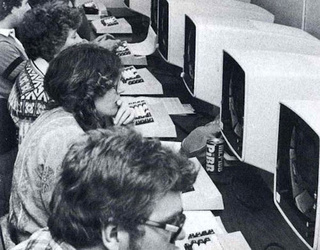 While Americans have been going to college for over three hundred and fifty years of our history, only within the past three decades has the landscape of higher education changed drastically. Students today now have less of a chance of becoming hired for a job after graduation, yet more and more of them are entering into the college ranks. How has the history of university studies changed in the span of a single generation? What was college like then and now?
While Americans have been going to college for over three hundred and fifty years of our history, only within the past three decades has the landscape of higher education changed drastically. Students today now have less of a chance of becoming hired for a job after graduation, yet more and more of them are entering into the college ranks. How has the history of university studies changed in the span of a single generation? What was college like then and now?
Personal Computing
Perhaps no change has affected college life like the availability of computers. In the 1980s, students could take computers to university, but only the wealthiest could afford them. Indeed, many colleges may not have even offered computers to students, instead providing typewriters to compose lab reports and essays with. Today, a computer is a mandatory part of any higher education program, and it is extremely difficult to go through college without one. Teachers communicate exclusively by email to their students outside of the class, while more and more courses are moving to the digital classroom itself in order to provide instruction across time and space. Indeed, it is now possible to get a complete university education in your own home with an Internet connection.
For Profit Universities
For most of American history, higher education has been a non-profit organization dedicated to improving student learning as well as generating research in order to advance knowledge. Today, however, the financial side of colleges has drastically changed how students view their time in class. For-profit universities offer certifications, associate’s degrees, and bachelor’s degrees for much less than state and private universities do. Though many for-profit schools are not certified and some employers have been less than eager to accept graduates, one in four college students attend for-profit schools since the price tag is less and the time commitment is minimal.
Loans and Debt
On the student side of the higher education equation, perhaps no factor has changed more in the past thirty years of history than the financial commitment to attend a university. Since these universities are non-profit and do not operate a business model that requires cutting costs, the price tag of attending a traditional four-year college has risen astronomically. Tuition at Berkeley University in California was only seven hundred dollars per semester in 1980; today it is nearly fifty times as much. This has resulted in trillions of dollars of student loan debt being lent out; more dollars are owed in student loan debt today than in credit card debt. Few universities have taken steps to be cost-effective, furthermore, meaning that the cost spiral shows no sign of slowing.
Adjunct Instruction
Thirty years ago, the majority of classes on a college campus were taught by professors who had tenure, full-time employment, and had been with the university for several years. Those days are long gone, however, as the business model has forced schools to recruit adjunct faculty to teach many courses. Adjunct professors are paid hourly, given only a single class per semester, have no benefits, and may not be subject to a contract renewal at the end of the year. The result is that many college professors are earning less at their job than minimum-wage workers.
Sports Spending
While collegiate sports have long been a means of fundraising for schools, the amount of money going into sports has ballooned. The top-paid state employees in forty of fifty states in the US are football or basketball coaches, with most coaches earning more than university presidents. The NCAA signs contracts with sponsors for billions of dollars, all the while refusing to pay athletes for their services to the school.
____________________
Author Bio
Ryan Ayers is a writer who creates informative articles in relation to education. In this article, he describes how college has changed over the past few decades and aims to encourage further study with a Norwich University Online History Degree.
